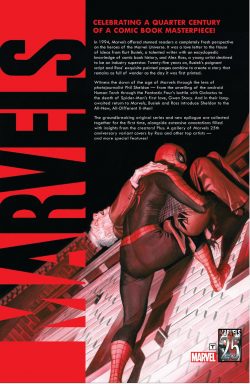
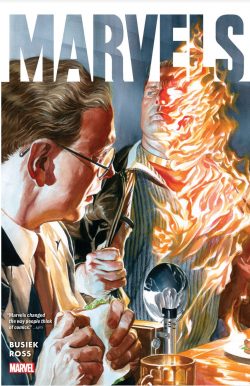
By Kurt Busiek & Alex Ross, with Steve Darnall, Mark Braun, Richard Starkings, John Roshell & various (MARVEL)
ISBN: 978-0-7851-4286-7 (TPB) 978-0-7851-1388-1(HC/Digital edition)
Every so often in mainstream comics something comes along that irrevocably alters the landscape of our art-form, if not the business itself. After each such event the medium is never quite the same again. One such work was 4-issue Prestige Format Limited Series Marvels by jobbing scripter Kurt Busiek and just-breaking illustrator Alex Ross. This year that landmark game-changing graphic collection turns 30…
I’m usually quite reticent in suggesting people read stuff I know damn well they’ve almost certainly already seen, but apparently every day is somebody’s first, and as years pile up and more stuff gets made, even certified bona fide “unmissables” get shuffled into touch and forgotten…
This tale is all about history and human perspective, following the working life of photo-journalist Phil Sheldon, whose career paralleled the double dawning of the heroic era; when science, magic, courage and overwhelming super-nature give birth to an Age of Marvels…
The saga opens with Alex Ross’ brief, preliminary retelling of the origin of the Golden Age Human Torch as first seen in Marvels #0 (co-written by Steve Darnall and produced in classicist pic-&-text block format) before the story proper opens in ‘A Time of Marvels’. In 1939 a gaggle of ambitious young newspapermen discuss the “War in Europe”. Brash up-and-comer J. Jonah Jameson is trying to dissuade his shutterbug pal Phil from heading overseas, claiming there’s plenty of news to snap in New York…
Unconvinced, Sheldon heads to his next assignment: a press conference with scientific crackpot Professor Phineas T. Horton. The photographer’s head is filled with thoughts of journalistic fame and glory on distant battlefields and he almost misses the moment Horton unveils his artificial man: a creature that bursts into flame like a Human Torch…
From that moment on Sheldon’s life is transformed forever. His love-hate fascination with the fantastic miracles which rapidly, unceasingly follow in the inflammatory inhumanoid’s fiery wake is used to trace the rise of superhumanity and monstrous menace which comprises the entire canon of what we know as the Marvel Universe….
Soon the android is accepted as a true hero, frequently battling aquatic invader Sub-Mariner like elemental gods in the skies above the city whilst seemingly-human vigilante supermen like The Angel constantly ignore the law and daily diminish Phil’s confidence and self-worth. It’s as if by their well-meaning actions these creatures are showing that mere men are obsolete and insignificant…
Feelings of ineffectuality and inadequacy having crushed the camera jockey’s spirit, Phil turns down a War Correspondent assignment and descends into a funk. He even splits up with fiancée Doris Jaquet. After all, what kind of man brings children into a world with such inhuman horrors in it? Nevertheless, Sheldon cannot stop following the exploits of the singular human phenomena he’s collectively dubbed “Marvels”…
Everything changes with the arrival of patriotic icon Captain America. With the Land of Liberty in World War II at long last, many once-terrifying titans have become the nation’s allies and secret weapons, turning their awesome power against the Axis foe and winning the fickle approval of a grateful public. However, some were always less dutiful than others. When tempestuous Sub-Mariner again battles the Torch, Prince Namor of Atlantis petulantly unleashes a tidal wave against Manhattan. Phil is critically injured snapping the event…
Even after losing an eye, Phil’s newfound belief in Marvels never wavers and he rededicates himself to his job and Doris; going to Europe where his pictures of America’s superhuman Invaders crushing the Nazi threat become part of the fabric of history…
The second chapter jumps to the 1960s where Sheldon, wife Doris and daughters Jenny and Beth are – like most New Yorkers – at the epicentre of another outbreak of metahumanity… a second Age of Marvels…
Two new bands of costumed champions operate openly: A Fantastic Four-some comprising famous scientist Reed Richards and test pilot Ben Grimm plus Sue and Johnny Storm. Another anonymous team who hide their identities call themselves The Avengers. There are also numerous independent mystery men streaking across the skies and hogging headlines, which Jonah Jameson – now owner/publisher of the newspaper he once wrote for – is none too happy about. After all, he has never trusted masks and is violently opposed to this new crop of masked mystery-men. Phil is still an in-demand freelancer, but has a novel idea, signing a deal for a book of his photos just as the first flush of popular fancy wanes and increasing anxiety about humanoid mutants begins to choke and terrify the man in the street…
When the mysterious X-Men are spotted, Sheldon is caught up in a spontaneous anti-mutant race riot: appalled to find himself throwing bricks with the rest of a deranged mob. He’s even close enough to hear their leader dismissively claim “They’re not worth it”…
Shocked and dazed, Sheldon goes home to his nice, normal family, but the incident won’t leave him, even as he throws himself into work and his book. He worries that his daughters seem to idolise Marvels. “Normal” people seem bizarrely conflicted, dazzled and besotted by the celebrity status of the likes of Reed Richards and Sue Storm as they prepare for their upcoming wedding, yet prowl the streets in vigilante packs lest some ghastly “Homo Superior” abomination show its disgusting face…
Events come to a head when Phil finds his own children harbouring a mutant in the cellar. During WWII, Phil photographed the liberation of Auschwitz, and looking into the huge deformed orbs of “Maggie” he sees what he saw in the faces of those pitiful survivors. His innate humanity wins out and Phil lets her stay, but can’t help dreading what friends and neighbours might do if they find such a creature mere yards from their own precious families…
Hysteria keeps growing and the showbiz glitz of the Richards/Storm wedding is almost immediately overshadowed by the catastrophic launch of anthropologist Bolivar Trask’s Sentinels. At first the mutant-hunting robots behave like humanity’s boon but when they override their programming and attempt to take over Earth, it is despised and dreaded mutants who save mankind.
Naturally, the man in the street knows nothing of this and all Phil sees is more panicked mobs rioting and destroying their own homes. In fear for his family, he rushes back to Doris and the girls, only to find Maggie has vanished: the unlovely little child had realised how much her presence had endangered her benefactors. They never see her again…
The third chapter focuses on the global trauma of ‘Judgement Day’ as the shine truly starts coming off the apple. Even though crises come thick and fast and are as quickly dealt with, vapid, venal humanity becomes jaded with the ever-expanding metahuman community and once-revered heroes are plagued by scandal after scandal. Exhausted, disappointed and dejected, Phil shelves his book project, but fate takes a hand when the skies catch fire and an incredible shiny alien on a skyborne surfboard announces the end of life on Earth…
Planet-devouring Galactus seems unstoppable and the valiant, rapidly-responding Fantastic Four are humiliatingly defeated. Phil, along with the rest of Earth, embraces the end and wearily walks home to be with his loved ones, repeatedly encountering humanity at its best and nauseating, petty, defeated worst. However, with the last-minute assistance of the Silver Surfer – who betrays his puissant master and suffers an horrific fate – Richards saves the world, but within days is accused of faking the entire episode. Disgusted with his fellow men, Sheldon explodes in moral revulsion…
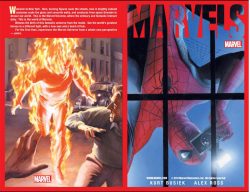
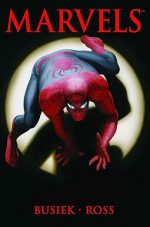
Phil’s photobook is finally released in concluding instalment ‘The Day She Died’. Now an avowed and passionate proponent of masked heroes, humanity’s hair-trigger ambivalence and institutionalised rushes to judgement constantly aggravate Phil even as he meets the public and signs countless copies of “Marvels”.
The average American’s ungrateful, ungracious attitudes rankle particularly since the mighty Avengers are currently lost in another galaxy defending Earth from collateral destruction in a war between rival galactic empires – the Kree and the Skrulls – but the most constant bugbear is old associate Jameson’s obsessive pillorying of Spider-Man. Phil particularly despises a grovelling, ethically-deprived young freelance photographer named Peter Parker who constantly curries favour with the Daily Bugle’s boss by selling pictures deliberately making the wallcrawler look bad…
Phil’s book brings a measure of success, and when the aging photographer hires young Marcia Hardesty as a PA/assistant whilst he works on a follow-up, he finds a passionate kindred spirit. Still, everywhere Sheldon looks costumed champions are being harried, harassed and hunted by hypocritical citizens and corrupt demagogues, although even he has to admit some of the newer heroes are hard to like…
Ex-Russian spy Black Widow is being tried for murder, protesting students are wounded by a Stark Industries super-armoured thug and in Times Square a guy with a shady past is touting himself as a Hero for Hire. When respected Police Captain George Stacy is killed during a battle between Spider-Man and Doctor Octopus, Jameson is frantic to pin the death on the webspinner, but hero-worshipping Phil digs deeper. Interviewing many witnesses – including the murderously malign, multi-limed loon himself – Phil consequently strikes up a friendship with Stacy’s daughter Gwen, a truly sublime young lady who is inexplicably dating that unscrupulous weasel Parker…
One evening, hoping for another innocuous chat with the vivacious lass, Phil sees her abduction by the Green Goblin and, desperately giving chase, watches as his vaunted hero Spider-Man utterly fails to save her from death. Her murder doesn’t even rate a headline; that’s saved for industrialist Norman Osborn who is found mysteriously slain that same night…
Gutted, worn out and somehow betrayed, Sheldon chucks it all in, but seeing Marcia still has the fire in her belly and wonder in her eyes, leaves her his camera and his mission…
Although this titanic tale traces the arc of Marvel continuity, the sensitive and evocative journey of Phil Sheldon is crafted in such a way that no knowledge of the mythology is necessary to follow the plot; and would indeed be a hindrance to sharing the feelings of an ordinary man in extraordinary times.
One of Marvel’s – and indeed the genre’s – greatest tales (but you probably already know that and if you don’t what are you waiting for?), I count at least four separate versions available currently and suggest if you have any money left you opt for the 25th Anniversary edition that comes heavily annotated with numerous articles and extras. These include aforementioned prequel ‘Marvels Book Zero’, and the ‘Marvels Epilogue’ short story. The bonus section comprises a 39-page, panel-by-panel comparison of original 1960s Marvel material with the reinterpretations of #0-4 compiled by Jess Harrold: followed by ‘Marvels: The Proposals’ as Ross & Busiek pitched their big idea: four shots to get it just right, aided by an abundance of glorious ‘character studies’ incorporating a vast cast, and supplemented by text articles on the finished product from November 1993’s Marvel Age #130.
Busiek’s full scripts for #1-4 and a wealth of ‘layouts, pencils & Original Art’ (11 pages) follow, before diving deeper in with a 6-page peek ‘Inside Alex Ross’ Marvels Epilogue Sketchbook’. More commentary follows with recovered Introductions, Busiek’s in-story prose pieces ‘Marvels: The Articles’; 8 pages of Ross’ contribution via ‘Marvels: The Artistic Process’, and Harrold’s popular press features courtesy of ‘The Story of Marvels’, ‘Modern-Day Marvels’, ‘Understanding Marvels by Scott McCloud’, ‘McLaurin’s Mark on Marvels’.
Next comes a ‘Mahvels Parody’ by Darnall, Busiek, Ross & artist Mark Braun, accompanied by ‘Posters, Art & Homage Covers’, Ross’ ‘Marvels Collected-Edition Cover Gallery’, and material seen in previous collections, including an ‘Annotated Cover Gallery’; a selection of ‘Marvels 25th Anniversary Variants’, ‘Marvels 25th Anniversary Tributes Variants’ and ‘Marvels Epilogue Variants’: with 5- full page contributions from Paolo Rivera, Michael Cho, Gabriele Dell’Otto, Stephanie Hans, Daniel Acuña, Mark Brooks, David Mack, Julian Totino Tedesco, Mico Suayan & Brian Reber, Inhyuk Lee, Carlos Pacheco, Leinil Francis Yu & Sunny Cho, Adi Granov, Alan Davis, Mark farmer & Matt Hollingsworth, Nick Bradshaw, Gerlad Parel, Greg Smallwood, Marcos Martin, Tomm Coker, Yasmine Putri, Clayton Crain, Phil Noto, Simone Bianchi, Dave Johnson, Ron Lim & Dean White, Remsy Atassi, Dave Cockrum & Edgar Delgado, Fred Hembeck & Felipe Sobreiro, Skottie Young and more.
The epic history lesson ends with a list of ‘Marvels Sources’, citing where each re-envisioned scene first appeared in comics continuity before closing with Stan Lee’s Marvels TPB (1994) Introduction, full Acknowledgements and a final Afterword from Kurt Busiek & Alex Ross.
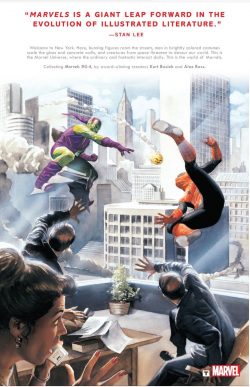
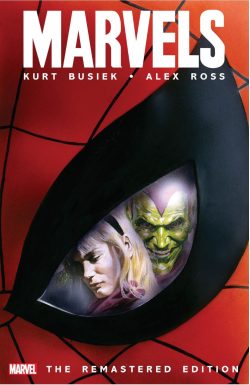
A truly groundbreaking achievement, Marvels – in whatever form you see it – is a comics tale you must not miss.
© 2020 MARVEL.
